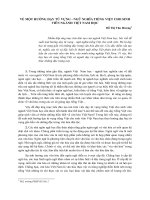Tu vung ngu nghia file ppt
Bạn đang xem bản rút gọn của tài liệu. Xem và tải ngay bản đầy đủ của tài liệu tại đây (71.18 KB, 21 trang )
Lexicology
Chapter 1:
Câu 1: State the five principal branches of lexicology.
Câu 2: Why is lexicology studied? What is its significance?
Câu 3: What is lexicology?
Câu 4: Lexicology in its relation to phonology and stylistics.
Câu 5: State the relationship between lexicology and
phonology; grammar.
Test No2:
Question 1: State the growth of the English vocabulary and the reasons
for that growth.
Question 2: Express the basic stock of words and its characteristics
Unit 2: Word structure and
formation
# Câu 1: What is the morpheme? Give its types.
# Câu 2: What are the types of words? Give example.
# Câu 3: Give the definition of word-formation and state its subject matter.
# Câu 4: What is the affixation? What are its types? And give examples.
# Câu 5: What is prefixation? State its definition and classification of
prefixes. Give examples.
# Câu 6: What is suffixation. Give its definition and classification of suffixes.
Give examples.
Practice
# Câu 1: Write the meaning of underlined morphemes.
a, antedate f, inactive
b, replay
c, manly
g, richer
h, empties
d, cheapest i, unable
e, typed
j, malfunction
# Câu 2: Underline the root morpheme in these words.
a, womanly f, enlighten
b, endear
g, Bostonian
c, infamous h, falsify
d, prewar
i, delivery
e, subway
j, kingdom
# Câu 3: Write the meaning of underlined morphemes.
1, antivirus 6, inexpensive
2, rewrite
7, poorer
3, manly 8, cries
4, youngest 9, unacceptable
5, walked
10, malfunction
# Câu 4: Use prefixes to form words with negative/ reversal meaning.
1, connect 6, to like
2, to understand
7, effective
3, regular
8, patient
4, normal
9, sense
5, standard 10, important
Lecture 3 & 4: Word structure
and formation (continued)
Câu 1: What is compounding? Its definition and characteristic features.
Give examples.
What is the discrimination between compounds and free word groups?
Câu 2: What is shortening? Identify its definition and types. Give
examples.
Câu 3: What is conversion? Identify its definition and types. Give
examples
Practice
Câu 1: Name the following compounds (Adj; Adv; Pre : N or V )
a, assistant-director
b, ups-and-downs
c, output
f, breakthrough
g, overtime
h, overturn
d, snowfall
i, get- rich- quick
e, pick-me-up
j, toothpick
Câu 2: Give the originals of these blends.
1, Smog
6, Medicare
2, telecast
7, Heliport
3, Interpol
8, Motel
4, Moped
9, Amerindian
5, Brunch
10, camcorder
Câu 3: Use prefixes to form words with negative meaning.
1, ability
6, grace
2, to qualify
7, effective
3, literate
8, polite
4, normal
9, sense
5, standard
10, Responsible
Câu 4: Use prefixes to form words with negative/ reversal meaning.
1, connect
2, to understand
6, to like
7, effective
3, regular
8, patient
4, normal
9, sense
5, standard
10, important
Câu 5: State the types of word formation for the following words:
1, eatable
6, BBC
2, goal-keeper
7, to skin
3, handwash
8, murmur
4, exam
9, to baby-sit
5, bike
10, to window-shop
Lecture 5: Semansiology
Câu 1: What are types of word meaning? State each type.
Câu 2: What are types of bookish words? Give examples for each type.
Câu 3: How many types are non-standard words subdivided into? Give
examples for each type.
Câu 4: What is metaphor? Give its definition & classification. Give
example.
Câu 5: What is metonymy? Give its definition & cases of metonymy.
Give example.
Semantics
Chapter 1 & 2
• Question 1: Difference between utterance and sentence
• Question 2: Condition for a homonym to be absolute?
• Question 3: Condition for a synonym to be absolute?
• Question 4: Base to distinguish form vs word expression.
• Question 5: Distinguish homonym and polysemy.
Câu 6: What are homonyms? State its definition & classification. Give
example.
Câu 7: What are synonyms? Give its definition & classification. Give
example.
Câu 8: What are antonyms? Give its definition & classification. Give
example.
Practice:
Câu 1: Comment on the type of homonyms
1, wait – weight
6, read ( adj ) _ read ( v )
2, sole – soul
7, match ( n )_ match ( v )
– bear (n) 8, right ( n ) _ right ( adj )
4, firm (n) – firm (a) 9, thought ( n ) _ thought ( pp )
5, flour – flower
10, rose ( n ) _ rose ( ps )
3, bear (v)
Chapter 3 & 4
Question 1: What is the base to distinguish metaphor and metonymy
Question 2: Give 2 examples of metaphor and explain it.
Question 3: Give 2 examples of metonymy and explain it
Question 4: Give 2 examples of necessarily true sentences and 2
examples contingently true sentences and explain it.
Question for discussion
What are the types of sense relation?
(Chapter 4, page 41)
Chapter 5:
Question 1: Give the example of grammatically correct sentence and
semantically correct sentence
Question 2: Types of processes? Give example for illustration
Question 3: Types of participants? Give example for illustration
Question 4: Types of circumstances? Give example for illustration
Chapter 7
• Question 1: What is presupposition? Give
examples for illustration.
• Question 2: What is implicature? State the
classification of implicature and give example of
each type.
• Question 3: State the maxims in conversation
recognized by Grice









